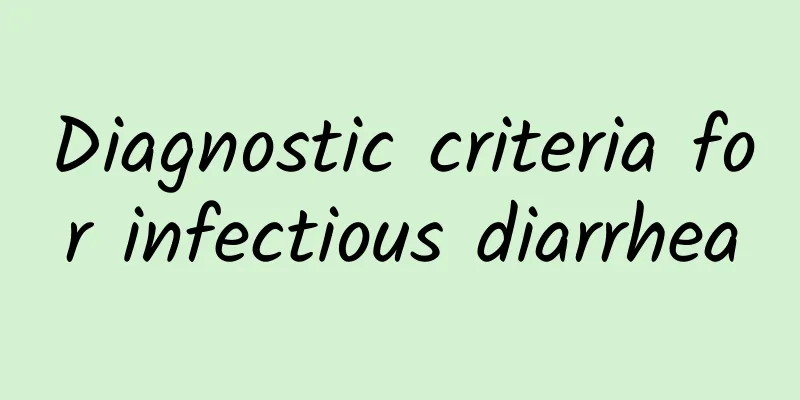Diagnostic criteria for infectious diarrhea

|
Diarrhea is a common disease in daily life. Eating unclean food, catching a cold, gastrointestinal cold, etc. may cause diarrhea. Once diarrhea occurs, the most worrying thing is dehydration. Therefore, the most important thing for diarrhea is not to let the body show symptoms of dehydration. The infectious diarrhea we are going to talk about today is mainly caused by bacteria, viruses, and fungi, and manifests as abdominal pain, nausea, vomiting, fever, and increased bowel movements. So how do you diagnose whether it is infectious diarrhea? Let's talk about its diagnostic criteria. Infectious diarrhea is divided into three types: acute, persistent and chronic. Acute infectious diarrhea generally lasts less than 14 days, persistent infectious diarrhea generally lasts 14-29 days, and chronic infectious diarrhea generally lasts more than 30 days. Diagnostic criteria for infectious diarrhea: 1. The stool contains mucus and blood. Routine stool examination of patients with infectious diarrhea may reveal mucus and blood in their stool. Red and white blood cells can be seen under a microscope. 2. The total white blood cell count and neutrophil classification increase. After a routine blood test for patients with infectious diarrhea, an increase in the total white blood cell count and neutrophil classification can be seen. 3. Hematuria, hemoglobinuria, and tubular urine. Due to viral or bacterial infection, the urine of patients with infectious diarrhea often contains hematuria, hemoglobinuria and tubular urine. 4. Increased serum fibrin degradation products. In patients with infectious diarrhea, not only does the serum fibrin degradation products increase, but also the blood BUN, CR, AST, ALT, BIL, LDH, CK, etc. may increase. 5. The total amount of unformed feces excreted per day exceeds 250 grams. After diagnosis, if it is confirmed to be infectious diarrhea, effective measures should be taken as soon as possible for treatment, such as diet therapy, eat more fresh vegetables and fruits, eat more foods high in vitamins, eat less easily digestible foods, eat less fried and greasy foods, and drink less canned fruit juice; rehydration therapy, oral rehydration salts, drink less water; drug treatment, oral adsorbents such as montmorillonite, pectin and activated carbon, or oral probiotics, or intestinal motility inhibitors such as loperamide and phenoxylate, or proud UN champion drugs such as metronidazole, or antiviral drugs such as nitazoxanide; Chinese medicine treatment, oral berberine hydrochloride. |
<<: What does chicken bone grass counteract?
>>: How much is the dosage of Platycladus orientalis leaves?
Recommend
The efficacy and function of star anise maple leaves
As people's research on traditional Chinese m...
The efficacy and function of walnut leaves
Walnut leaf is a common Chinese medicine. It can ...
The efficacy and function of Trillium leaves
The medicinal value of Trillium leaves is beyond ...
The efficacy and function of iron grass shoes
Many people choose iron grass sandals because of ...
Can cancer be transmitted between husband and wife? Four types of cancer are likely to develop into "couple cancer", so be careful
Author: Zhang Xiufeng, deputy chief physician of ...
The efficacy and function of Huangjizi
Huangjizi has great efficacy in traditional Chine...
What are the medicinal properties of Chinese medicine Angelica sinensis?
Speaking of Angelica, everyone knows that it is a...
The efficacy and function of Chuanxiong
Traditional Chinese medicine has a long history i...
The efficacy and function of ginger leaves
Ginger leaf is a commonly used medicinal material...
What to do if chickenpox breaks
When chickenpox occurs, many people will be very ...
Can "eating dirt" cure enteritis? What kind of weird linkage is this?
Recently, a new research result published in Natu...
Where does the waste from the ship's toilet go? Is it discharged directly into the sea to feed the fish?
If you were to ask which is the most polluted riv...
Insomniacs can't fall asleep, so they keep taking sleeping pills? The love-hate relationship between insomniacs and sleeping pills
Author: Jiang Molin Beijing Hospital of Tradition...
Which is better, Gynostemma tea or Apocynum venetum tea?
Nowadays, many people stay up late, which causes ...
The "Second Uncle" in the scientific community: He turned a disaster into a blessing twice and eventually became a great scientist
A video describing the past half of the life of t...









